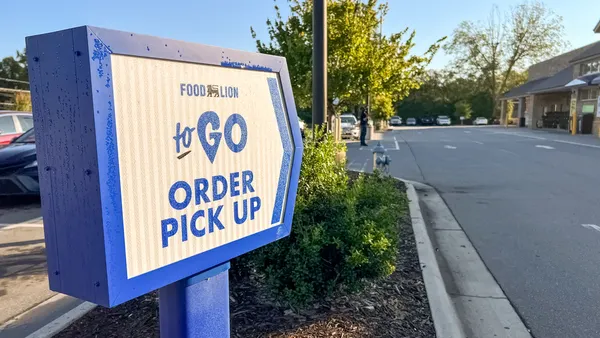-
Grocery retailers are trialing many different ways to cope with increased demand for online ordering.
-
New distribution trends include microfulfillment, dark stores, touchless technology, and more.
-
Both 'dark' and conventional e-commerce operations need effective data flow to unify the supply chain and ensure intelligent management.
-
The 'new normal' demands effective automation across the whole supply chain.
-
RFID is the low-barrier option best able to manage inventory, reduce costs, and cut waste – while safeguarding brand priorities and customer experience.
One effect of COVID-19 has been hard to miss in the US and beyond – the unprecedented surge in demand for omnichannel grocery. That includes home deliveries, curbside pickup, and click-and-collect. Retailers have been unable to keep up with unprecedented levels of online ordering, and consumers have been chasing what are often unavailable slots. The pandemic has dramatically increased online grocery sales, as consumers cope with the demands of social distancing, self-quarantine, and changes in lifestyle. We are seeing a new normal: higher numbers of online orders, delivered more frequently. Along with these orders, retailers are coping with mobile ordering, third-party delivery services, and rising demand for click-and-collect.
Consulting firm Bain & Company revealed that around 3-4% of US grocery spending was online before the pandemic, and this has now increased to 10-15%. Whole Foods reported that its grocery sales tripled, year over year, for the second quarter of 2020. Kroger saw its digital sales grow 92% in the first quarter of the fiscal year 2020. Such digital revenues include both online sales of products delivered directly to customers and also revenue from curbside pickups.
After struggling to meet the deluge of demand at the start of the pandemic, grocery retailers have since mounted a strong response, and COVID-19 has proved to be a catalyst for very significant operational changes. Retailers are investing in automated fulfillment capabilities and looking for the best ways to leverage their physical store network. Microfulfillment is also a trend that is here to stay, with short lead times and localized distribution.
We are now observing an all-out effort to upgrade retail and supply chain systems, and to identify weaknesses and bottlenecks. Across the sector, new technology trials and pilots are underway – at an ever-faster pace – and these trials are expected to become more widely adopted very quickly to meet changing consumer habits. Those habits are undoubtedly here for the time being and are expected by many to persist as COVID-19 subsides. We are likely to be heading for a future where consumers rely increasingly on e-commerce for transactional purchases such as toilet rolls, while still using conventional outlets for experiential purchases such as market produce.
Automation technology has emerged as a central component of the efforts to accelerate e-commerce capabilities. FastCompany highlights the trend for retailers to turn physical locations into so-called 'dark stores' – miniature warehouse-like spaces where online orders are packed for pickups and deliveries. A high-profile recent dark store opening was an Amazon.com facility in Brooklyn devoted to Whole Foods’ e-grocery fulfillment. The store had already been planned but became a higher priority in the context of COVID-19. Another Whole Foods location in Baltimore is online-only, while a San Francisco store closes to the public after 1pm each day.
Such significant changes have to be supported by the entire supply chain. Both dark and conventional e-commerce operations share one critical need: effective and accurate data flow and sharing. Only reliable and timely data can unify previously isolated components of a supply chain into a single, intelligently managed whole.
The future of grocery e-commerce lies in an ecosystem where different companies and systems can communicate with each other without obstacles. The alternative is data siloing, with all participants having to make best guesses and suffer the consequences from unforeseen knock-on effects. Effective automation avoids fragmented technologies and provides the transparency needed for reliable inventory management. Companies can then respond quickly to market changes, for example pivoting from hospitality to retail or transforming in-person sales to online.
For grocers, new fulfillment models depend on knowing an item really is in stock; that they have picked the right products for an order; and that those products are going to the right person. Retailers also need to give customers the ability to self-service safely for in-store purchases. No single 'magic bullet' could be said to exist for all of these challenges, but RFID offers very substantial benefits. It enables excellent traceability, allows existing store designs to be used without retrofitting, and works well for items that resist visual identification and require product weight data. Crucially, RFID means that brand priorities and optimal customer experience take precedence over technical needs.
Unlike vision-based systems, RFID tags can trace at item level from source to shelf, for dramatically improved visibility, accuracy, and traceability across the supply chain. The addition of blockchain also enables straightforward logging of chain-of-custody. Automated management of expiry dates means less waste from expired products, saving costs, and reducing waste. This contrasts with vision systems, which cannot easily track expiry without a lot of additional work by staff.
Avery Dennison's digital ID technologies such as RFID are designed to fit rapidly into existing operations without imposing unnecessary demands and costs. Adopting RFID means seeing up-to-date and accurate inventory, with fewer product substitutions and out-of-stock (OOS) issues. The simplicity of adoption also enables a healthy balance between Profitability Index (PI) and working capital.
One thing is certain: post-COVID retailing will look very different, and digital ID technologies will be making a major contribution to the changes ahead.
Find out more about how Avery Dennison can help you maximize your digital strategy. Or reach an Avery Dennison RFID strategist here.










